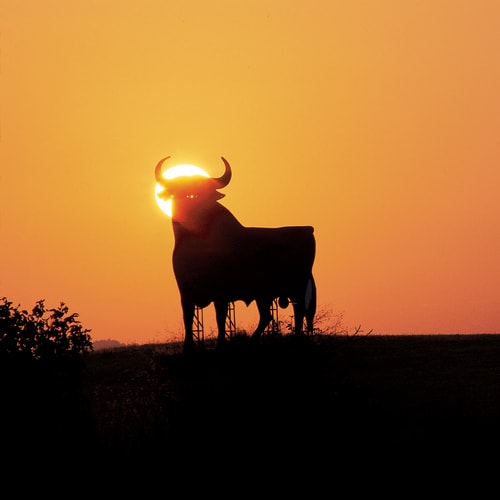Spain: The Importance of Bulls
May 2005




I could hardly believe my eyes. I saw a couple of brave young men vaulting over bulls in the middle of Ciudad Rodrigo. I turned to my wife Ruth and said, "Isn't that what young men did in the Minoan culture thousands of years ago?"
We were sitting in the makeshift stands which had been erected for the running of the bulls in the plaza mayor of the agricultural town in Extremadura. This was no Hemingway bacchanal a la 'The Sun Also Rises'. I did not catch a glimpse of Ava Gardner! Hardly. Next to us on the rickety stands sat a couple of middle-aged farm wives catching up on the latest gossip. Close by was a family group drinking wine and carving slices of jamón from a leg they had brought with them. It had more the feel of a community picnic.
We were witnessing an elemental rite of passage in which young men showed their valor before their approving neighbors by tangling with the bulls. I am no anthropologist, but it seems to me this was an echo of the distant past. In prehistoric times bulls played an important part in the religious ceremonies of Iberian tribes living in Spain. Thousands of years ago during the time of the Minoan culture in Crete the bull-cultus was central. We see evidence of the influence of bulls throughout the Iberian Peninsula, whether it be the cave paintings of Altamira, or the stone bulls of Las Arenas de San Pedro in Avila.

Another echo of this ancient rite of passage into manhood is La Corrida, the misnamed "bullfight". In this ritual the bull, the essence of animal virility, is confronted and subdued by a sole human being, the matador, protected only by his faith, his valor and a thin sword. The magnificent Toro Bravo he faces is an archaic strain of bulls that today is only preserved in Spain. Their ancestors are the primitive 'urus', which used to be spread out over wide parts of the ancient world.
Whether or not you approve of - or even understand - the corrida, it is a national tradition that many believe is the very essence of Spanish culture: a ritual that binds an historically fragmented collection of regions into one country and that predates Spain itself. The corridas were even held in the midst of the bloody days of the Civil War!
"Our literature, our paintings, all of our artistic expressions are influenced by the world of the bull," one Spaniard observed, " It explains who we are." I think he is right. In what other country would you find huge black silhouettes of fighting bulls looming on the horizon as you wend your way through the rolling hills of the countryside?
Originally it was a brilliant marketing strategy of the Osborne Bodegas, makers of sherry and brandy in my "hometown" of El Puerto de Santa María. Over much of Spain they installed colossal billboards cut in the shape of the bull with the word Osborne emblazoned in red letters across his body.
After the passing of Franco the reforming national legislature, the Cortes, passed sweeping legislation including a ban on all roadside billboards throughout the nation. But the ink had hardly dried on the document before they realized they had unintentionally done an unthinkable thing: the massive bulls would be removed from the landscape! So they went back into session and declared the bull silhouette a national treasure, so long as the brand name was removed!
This year many of Spain's mighty bulls are being confined to the ranch under a quarantine aimed at halting the spread of a disease known as bluetongue. It is only harmful to sheep, not other livestock or humans. Still, it puts the government in the unenviable position of trying to balance the interests of the fighting bulls, which represent a tradition that is nearly sacred in some parts of society, with the venerable sheep industry.
"The current measures would create the gravest crisis we have ever known," Enrique Garza Grau, secretary general of the National Association of Organizers of Bullfighting Spectacles, said in an interview. The gravest crisis? I know Spaniards often speak in hyperbole, but as I think about it, Señor Garza may not be far from the mark.
Tu Amigo,
Don

